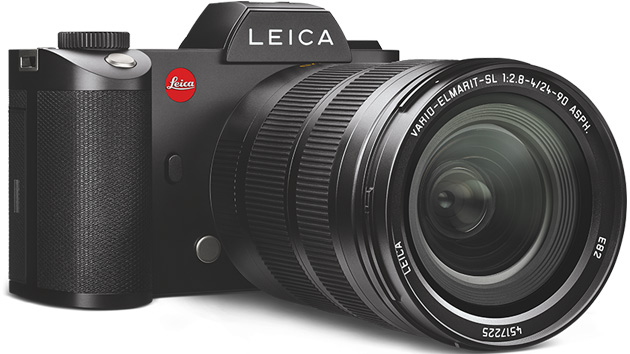4K DCI at 24 fps, 10-bit 4:2:2 Video and 24 MP Stills in a Chic Leica Body
Leica has introduced the Leica SL, a full-frame, autofocus camera that shoots 4K video internally and outputs a 4:2:2 10-bit HDMI 1.4 signal with timecode. While the new camera has many features that make it appealing to professional still photographers, the video options make it another serious contender in the compact mirrorless camera category currently occupied by the Sony a7R II and Panasonic Lumix GH4.
How does it stack up against the competition? The new Leica SL shoots 4K DCI in Super 35mm crop mode at 4096×2160, as does the Lumix GH4; Sony's a7R II still beats them both by capturing a 5K resolution frame and reducing it to 4K. Although the SL's autofocus feature challenges the novelty of Sony's a7R II, Leica's ISO range of 50 to 50000 also can't match the ISO peak of 102400 you can get with the a7R II. The Leica SL features V-Log L Gamma, which the Lumix GH4 now does thanks to a recent upgrade (in the latest Lumix GH4R, it's built in). The Sony a7R II, in contrast, features S-Log2 Gamma.
But Leica has put a lot of engineering into this new model, starting with the 24 megapixel full-frame CMOS sensor and its EyeRes integrated electronic viewfinder, which looks to be the highest resolution EVF on the market. Meant to resemble an optical viewfinder in clarity, the 4.4 megapixel EVF gives the user a complete view of the full frame directly from the CMOS sensor and can be magnified .8x for an even clearer view. That megapixel count would give it somewhere above a Quad XGA resolution, topping even Sony's XGA OLED EVF. Sony's OLED technology alone may render those extra pixels needless, but Leica's specs are still impressive.
The bigger question, however, is are those extra pixels in the EVF—and that hip little red circle with the silver script—worth the steep difference in price? The body-only Leica SL, which can be pre-ordered now from B+H or the Leica Store in Soho, is listing for $7,450. The GH4, by comparison, lists for under $1,500. Even Sony's Alpha a7R II, with its 42 megapixel (7952×5304) full-frame CMOS sensor, is a relative bargain at $3,200.
Under the hood the Leica SL is driven by the Maestro II image processor co-developed with Fujitsu Semiconductor Europe and introduced in the company's 2014 S series. It features an extremely fast processing speed—still picture burst rates up to 11 frames per second at full 24 MP resolution or 4K video (specifically UHD) up to 30 fps—but relatively low power consumption and 2 GB of buffer memory. If you want full 409 x2160 footage, you can only shoot at 24 fps. You can also shoot at 120 fps at standard HD resolutions.
Leica will launch three new SL System lenses over the long term, although only the Vario-Elmarit-SL 24–90 mm f/2.8–4 ASPH zoom lens will be available when the camera is expected to ship in November. With front glass hardened by an AquaDura coating, the future lenses will include the APO-Vario-Elmarit-SL 90–280 mm f/2.8–4 and Summilux-SL 50 mm f/1.4 ASPH. Existing Leica T/TL-mount lenses will work without an adapter, and all other Leica lenses, including its popular Summilux C primes, will be easily swapped out with the appropriate adapter. The company says the SL has even been specifically engineered to work with its manual M series lenses, another fine fusion of old-school function and advanced yet classic form that Leica does so well.
Did you enjoy this article? Sign up to receive the StudioDaily Fix eletter containing the latest stories, including news, videos, interviews, reviews and more.









